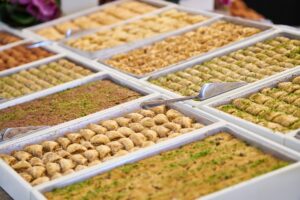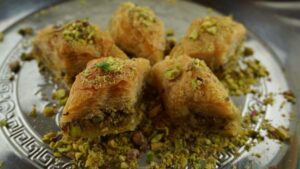In the realm of delectable desserts, few can rival the richness and sophistication of baklava. This sweet pastry, composed of layers of thin dough, nuts, and a generous drizzle of honey or syrup, is a cherished treat across the Middle East, the Balkans, and the Mediterranean. Its complex history and the diverse cultural influences that have shaped it make baklava a true culinary marvel.
Layers of Influence
One of the most intriguing aspects of baklava is the layers of cultural influence that have shaped its development.
The origins of baklava trace their roots to ancient antiquity. Some 2,800 years ago, in the eighth century B.C.E., the Assyrian Empire, spanning regions now encompassing modern-day Iraq, Iran, Kuwait, Syria, and Turkey, crafted a precursor to baklava. During special occasions and gatherings, they artfully layered unleavened flatbreads, interspersing them with finely chopped nuts, creating a delectable treat.
Centuries would pass, and the culinary world would see the emergence of the Ancient Greek and Roman “placenta cake,” a far cry from the connotation associated with the word “placenta” today. Derived from the Greek term “plakous,” meaning “cheese cake,” this delicacy consisted of multiple layers of dough enveloping a sweet filling of cheese and honey, tantalizingly enhanced with the fragrance of bay leaves.
However, it wasn’t until approximately 500 years ago, during the illustrious reign of the Ottoman Empire, that the earliest incarnations of baklava, as we recognize it today, came to fruition.
Throughout history, baklava held a special place as a confection reserved for celebratory occasions, primarily due to the intricate skill required to craft it and the costly nature of its key ingredients, which included honey, sugar, and an assortment of nuts. During the era of the Ottoman Empire, baklava acquired a near-sacred status, particularly during the holy month of Ramadan. It was during this time, commencing in 1520, that a unique tradition known as the Baklava Procession emerged. During Ramadan, the Ottoman sultan would famously bestow vast quantities of baklava upon his most esteemed warriors, the Janissaries. This grand spectacle involved the baking of hundreds of trays of baklava in the palace kitchens, with each tray intended for every ten Janissaries. These trays were meticulously wrapped in cloths to safeguard them from dust and then elegantly arranged in the Second Court of the palace. This tradition endured until the Janissary Corps was disbanded in 1826, one and a half months following the Baklava Procession, remaining a beloved annual spectacle for generations.
Intriguingly, baklava transcended religious boundaries in the Ottoman Empire. Ottoman Christians incorporated baklava into their observance of Lent, using the pastry to symbolize the 40 days of Lent with elaborate creations featuring up to 40 layers of delicate phyllo dough. Others opted for 33 layers, representing the 33 years of Christ’s life. Meanwhile, Jewish communities throughout the empire embraced baklava as well, notably serving it during the holidays of Rosh Hashanah and Purim. This culinary convergence mirrored the broader cultural mosaic that defined the Ottoman Empire, where baklava served as a delectable embodiment of shared traditions and celebrations across diverse faiths.
Ingredients and Preparation

At the heart of baklava lies its signature ingredients: layers of phyllo pastry, finely ground nuts (usually pistachios, walnuts, or almonds), and a syrup or honey mixture. The process of making baklava is an art form in itself. Thin sheets of phyllo pastry are painstakingly layered, with each sheet brushed lightly with melted butter or oil to achieve the desired flakiness. A generous sprinkling of crushed nuts is spread across the layers, adding a delightful crunch and nutty aroma. The pièce de résistance is the pouring of fragrant syrup or honey, which soaks into the layers, creating a sweet, sticky masterpiece.
A Culinary Ambassador
Baklava’s irresistible combination of textures and flavours has turned it into a beloved dessert worldwide. It’s not only a dessert but also a symbol of hospitality and celebration in many cultures. It graces the tables of weddings, holidays, and special occasions, acting as a culinary ambassador of the diverse regions that claim it as their own.
Due to it’s long and involved history, Baklava has become more than just a dessert; it’s a testament to the intricate web of history and culture that defines the Middle East, the Mediterranean, and the Balkans. Its layers tell a story of centuries-old trade routes, culinary cross-pollination, and a shared love for the sweet things in life. So, the next time you indulge in a piece of baklava, remember that you’re not just tasting a pastry; you’re savouring a slice of history and culture as complex and rich as the dessert itself.
For those who want to take Baklava out of history and into their own homes, here is a simple recipe:

Ingredients:
For the Baklava:
- 250 grams of phyllo pastry sheets
- 150 grams of unsalted butter, melted
- 200 grams of mixed nuts (e.g., walnuts, almonds, and pistachios), finely chopped
- 1 teaspoon ground cinnamon (optional)
For the Syrup:
- 200 grams of granulated sugar
- 150 milliliters of water
- 1 tablespoon lemon juice
- 1 cinnamon stick (optional)
- 4-5 cloves (optional)
- 1-2 strips of lemon or orange zest (optional)
Instructions:
1. Prepare the Nuts:
- In a food processor, finely chop the mixed nuts. You can also chop them by hand. Add a teaspoon of ground cinnamon if you like for extra flavour. Set aside.
2. Prepare the Syrup:
- In a saucepan, combine the granulated sugar, water, lemon juice, and any optional spices or citrus zest.
- Stir over medium heat until the sugar dissolves.
- Once the sugar has dissolved, reduce the heat and let the syrup simmer for about 10-15 minutes, until it thickens slightly.
- Remove it from the heat and let it cool. Once cooled, remove any spices or zest strips.
3. Assemble the Baklava:
- Preheat your oven to 180°C
- Brush a baking dish (usually around 22×33 cm) with melted butter.
- Place one sheet of phyllo pastry in the dish and brush it generously with melted butter.
- Continue layering and buttering sheets one by one until you have about 6 sheets as a base layer.
- Sprinkle a thin, even layer of the chopped nuts over the pastry.
- Add another layer of phyllo pastry, brushing each sheet with butter as before.
- Continue the layering process, alternating between pastry and nuts until all the nuts are used up. Finish with a final layer of pastry, using about 6-8 sheets to create a top layer.
4. Cut into Diamonds:
- Before baking, use a sharp knife to cut the baklava into diamond or square shapes. This will make it easier to serve once it’s baked.
5. Bake:
- Place the baklava in the preheated oven and bake for about 40-45 minutes or until it turns golden brown and crispy.
6. Pour the Syrup:
- As soon as the baklava comes out of the oven, immediately pour the cooled syrup evenly over it. Make sure to cover all areas.
7. Let it Cool:
- Allow the baklava to cool completely at room temperature. This will help the syrup to be absorbed and give the pastry time to become crisp.
8. Serve:
- Once cooled, carefully separate the pieces along the cut lines you made earlier.
- Serve your homemade baklava and enjoy!
Baklava is best enjoyed fresh but can be stored in an airtight container for a few days. It’s a delightful treat with a perfect balance of sweetness and nuttiness!


